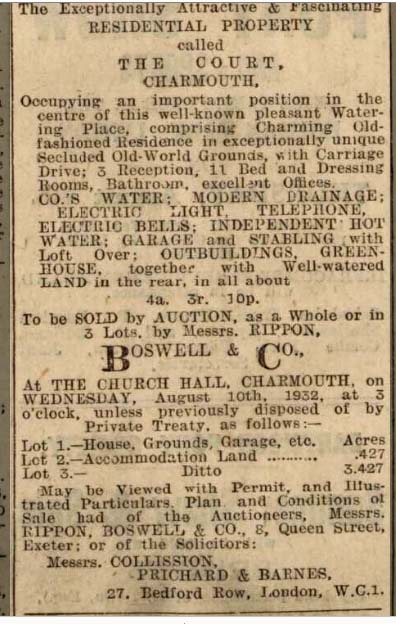|
The Court. The Street. Charmouth |
Scroll down to find out more about the property.
Click on images or Charmouth Home to return back. |
|
1841 Tithe Map showing site of The Court (no.66-late John Bragge) and adjoining Almshouses |
| The Court is the large Victorian building with an extensive forecourt that stands on the north side of The Street almost opposite The Royal Oak. It is one of a number of Villas that were built for wealthy families in Charmouth in the mid nineteenth century which give the village its variety and charm. But as with many of the houses, its history is much earlier than its present day appearance. In fact a building would have stood on the plot as far back as the 13 th Century. For in 1297 there is record of a Guildhall where the Manor Courts would be held under the auspices of the Monks of Forde Abbey who owned this village with many others in the vicinity. It is in this year that the ancient Cartulary details the laying out of the village into burgages stretching back on either side of the Street. Each plot was to be four perches (22 yards) by twenty perches (110 yards), which is a half-acre. The present day boundary of The Court would have taken in two of these plots, with remnants of the boundary walls still to be seen. After the Dissolution in 1549 Sir William Petre, briefly owned the Village and his Rent Roll can still be seen in Devon Record Office in Exeter. Though it provides a detailed list of tenants and their properties it is difficult to identify The Court from it. But it is clear that at the end of the 17 th Century an Almshouse was built on the Eastern half of the plot. For in 1661 Anthony Tutchen, a Mariner gave his freehold house and an acre of ground on the west side of Lower Sea Lane (part of Single Common) for the benefit of Seamen, Seamen's wives and children. Originally the gift was made in stockings and shoes, but later an Alms House was substituted on the site. This house contained three rooms below and three above and was occupied by six aged, poor, people |
 |
An extract of John Bragge`s Will leaving his property in Charmouth to William Bragge |
|
Charmouth. To be sold in fee, by auction by mr. Fowler,
At the George Inn, in Charmouth on Wednesday the 25th day of September,1839, at six o clock in the evening,
All those two dwelling houses adjoining each other, pleasantly situated in the Centre of the delightful Watering Place of Charmouth, with a Court in front, and an extensive Walled Garden, of a superior description behind, well stocked with choice Fruit Trees.
One of the dwelling houses is in occupation of Doctor Thomas, and consists of a drawing and dining room of good dimensions, six bedrooms, with a two stall stable, and other requisite Offices. The other was in the occupation of the late William John Bragge, Esq, and comprises a dining room, five bed rooms and various convenient offices attached and the garden is occupied by Mr. Moore.
Dr. Thomas and Mr. Moore are yearly tenants. The occupancy of the former commenced on the 27th August, and that of the latter at Lady Day. Possession of the House in which Mr. Bragge resided May be obtained on completion of the purchase.
For viewing the premises application May be made to the respect Tenants and to Susanna Stuckey, and further particulars to Mr. Moore, Solicitor, Yeovil, Somerset |
Last Will of William John Bragge - executors -William Poole of Tintinhull and John Moore of Yeovil. Four Nephews - Samuel Harris White, Charles Hannah White, George White and Edward White. And niece Elizabeth White in equal shares. Charles Higginson and Thomas Bedwell are witnesses. He also bequeathed to his servant Susan Stuckey nineteen pounds and aunt Charlotte Bragge the sum of £30. William John Bragge 7th October 1839. |
|
| The Court is again put up for sale in 1848 by Mr. Moore, Solicitor of Yeovil. This time Mr. Henry Smith and Captain Forward are renting the two adjoining houses. |
|
1851 Census has Samuel Foward as living in part of The Court. |
|
1861 Census has Thomas Bartlett living in other part of The Court. |
|
| Again in 1852 The two adjoining houses were put up for sale, This time Mr. Bartlett occupied the other side to Captain Forward. |
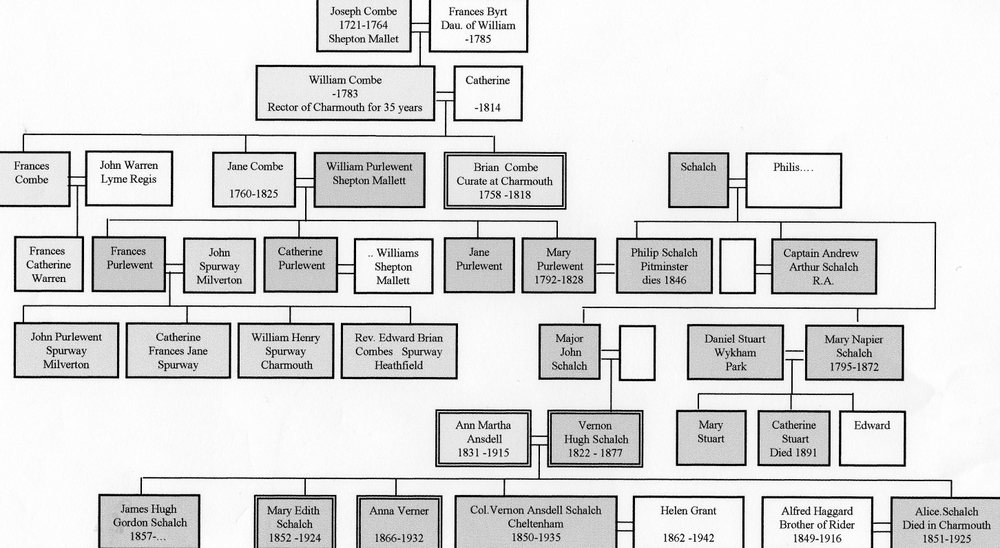 |
The Family Tree linking the Combes, Stuarts and Shalch Families |
| . The 1851 Census shows one widow and her family still living in one part and other elderly widows living in the other parts. The Charity was known as The Stocking and Shoe after the original use of the bequest. The name still continues in the name of a cottage to the east of the plot on the site of part of the original building. The 1841 Tithe Map for Charmouth shows 3 small cottages (nos. 64 & 65), which formed the Almshouse that were owned by the Parish. These adjoined two much larger houses (no.66). A very early photograph and a watercolour dating back to 1850 show this building with a bow window and a high wall separating it from the Almshouse. The occupier was Henry Smith, and his family who was one of the many Bakers to be found in Charmouth at the time. By 1850 the larger house had been bought by Rawlin Mallock, a wealthy Attorney living at High Hill in Axminster. When he dies in 1855 he leaves his family considerable property in the surrounding area and there is a mention in his long Will to his �tenement in Charmouth. |
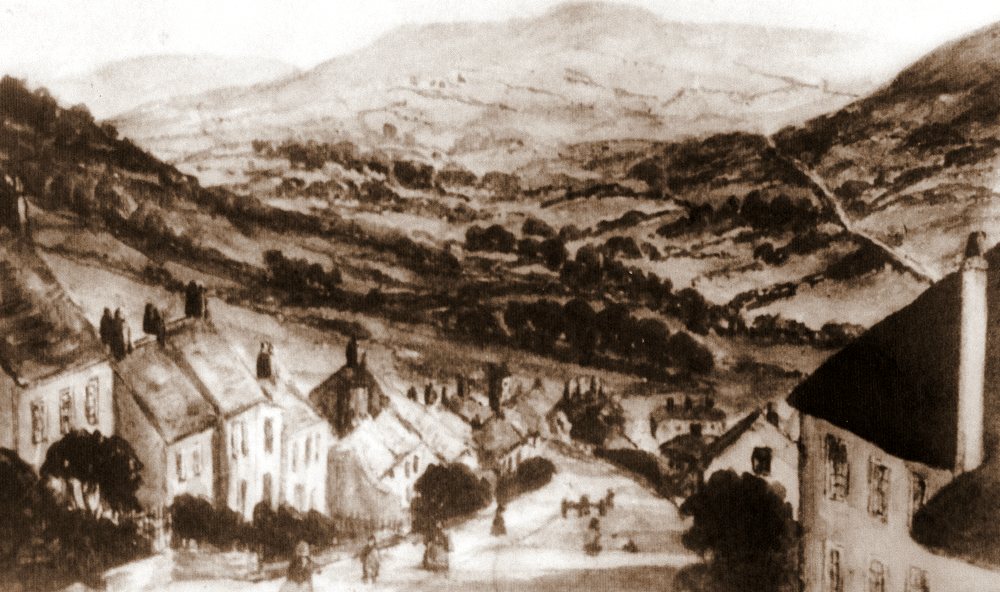 |
This view of the Street painted c.1850 shows clearly in the centre the high wall adjoining the fomer row of cottages, which inclded the Almshouses that were to bcome the site of The Court in time. |
It must have been shortly after that it was put up for sale by his wife and is purchased by a Mrs Stuart. One of the reasons for her moving here was probably the fact that her brother Philip Schalch was the owner of Backlands Farm. The family connection to this farm dates back to 1788 when Rev. Brian Combes had bought it on the death of the Lord of the Manor, Richard Henvill. He was Rector of Catherstone and Charmouth as had been his Father, William who had held the post before him for over 35 years. It consisted of buildings and a large area of farmland to the north of the Street. After Brian's death in 1818 his large personal Estate was left to his five nieces Frances Catherine Warren, Frances Purlewent, Catherine Purlewent, Jane Purlewent and Mary Purlewent. It was the latter who was to marry Philip Schalch, whose German forebears had opened the foundry at Woolwich Arsenal in the early 18 th century. Land Tax returns for 1825 show it as Combs Farm, owned by Warren & Co (the heirs) and rented by James Powell. But by 1840 it is Captain Philip Schalch who is detailed as owner of the 23 acres with a rate of £1-12s.
The complicated interconnected Family tree for the Combes, Schalch`s and Stuarts, which can be seen on the www.charmouthhistory.com website show that members were to be active in the villages affairs for nearly 200 years. But it is Mary Napier Stuart (nee` Schalch) who is most relevant in the history of The Court. Mrs Stuart as she is so often referred to in documents of the time was in fact Mary Napier Stuart who had been married to Daniel Stuart. Research into his background has revealed a fascinating story whose life was one of a self made Newspaper owner, journalist and entrepreneur. His will of 1846 detail a long list of properties around Banbury, Oxford and in the centre of London that he owned. Born in 1766 in Edinburgh, he was later to move to London where he made his fortune. Originally a journalist on the Morning Post he went on to pu rchase the newspaper in 1795 and by employing writers such as Samuel Coleridge, Robert Southey and William Wordsworth, increased its status and its circulation to become the largest paper after the Times. In 1813 he married (Mary Napier, daughter of Major Andrew Schalch, of the Royal Artillery), and the following year he bought the lease of 106 Harley Street. By 1817 he had purchased Wykham Park, an estate (in all about 300 acres) near Banbury, which had formerly belonged to the Dashwood family. The family would divide their time between the two properties. It was said that news of the death of his eldest son, a lieutenant in the Army from yellow fever, in the West Indies, aged him and he was to die soon after in 1846. The family property in Harley Street continued to be used by Mrs Stuart after his death, but she sold Wykham Park about the same time that she purchased Rawin Mallock`s house in Charmouth in 1855. She would have been 60 years of age by then and is shown living with her daughter Catherine. |
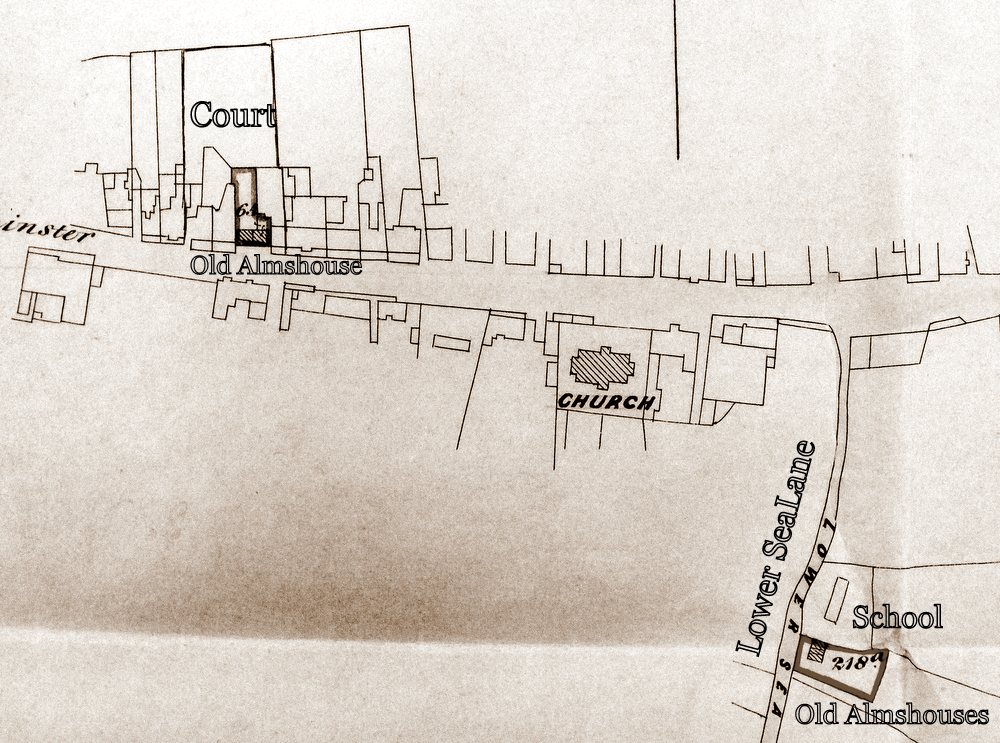 |
A Map dated 1867 showing the old Almshouses which were to be demolished and replaced with new built Almshouses by the School in Lower Sea Lane. |
In due course she buys the adjoining properties from the Misses Fisher and Sergeant Kinglake. The three cottages were converted into 'The Court' adding a drawing room and kitchen, an inner and outer hall with porch by about 1864. She employed William Eveleigh a builder from Morcombelake and Jessee Rafsey to carry out the carpentry. Sadly Mrs Napier Stuart was blind and Reg. Pavey in his notes on the house tells of an episode whilst the house was being built of scaffolding having to be erected in the stairwell so she could touch and inspect the work being carried out. Unfortunately the house was not as she wanted it as the entrance faced on to the ancient dilapidated almshouses and though she could see the sea she needed to safeguard the view over fields on the other side of the Street. Thus begins an interesting saga that ultimately provided her with what she wanted. For she purchases a field in 1864 on which stood a cow shed belonging to John Hodges a butcher, and goes on to build two almshouses to accommodate six poor people. The site is on the east side of Lower Sea Lane (on the corner of Meadow Way) by the old School. This new building replaced the old one next to her house, which is then demolished, and a coach house constructed on part of it. Both buildings stand today, though the Almshouse has long since been converted into housing.
She then buys part of Fountain Mead opposite The Court so she can have a view of the sea from her library, from Miss Short, the owner of Charmouth House. It later became known as Court Field and was the site for many years of the Village Club Fair held every Whit Monday. A house behind the War Memorial bears that name to day.
In due course she becomes the largest landowner in the village by paying £2350 to John Purlewent of Milverton, Somerset for her brothers former farm, Backlands in 1870. John is the son of Frances Purlewent, one of the five nieces of Rev. Brian Combes who inherit substantial property in the village. By the time of her death in 1872, aged 77 she is shown as also owning Stonebarrow Farm, the East Cliff and several fields in the Lower Sea Lane. Her daughter, Catherine, then aged 54, inherits her substantial wealth. But her mother ensures she continues residing at The Court by stipulating that she must not marry and spend at least four months a year there.
A number of memorials exist to the family in Charmouth church. These include a window on the birth of Christ by Mrs Stuart of the Court� , and two others in memory of her brother Philip Schalch Esq. The Font has a plaque in memory of Mary Napier Stuart - widow of Daniel Stuart of Wykham Park, Oxon. Erected by her daughters Mary & Catherine Stuart and Lady Baynes�. |
 |
Her daughter continued to own The Court until her death. She had intended leaving her estate to her nephew Vernon Hugh, son of her brother, Major John Schalch. But he had died in 1877 and it was his widow, Anna Martha Schalch who was to inherit the property in 1891.She had five children and it was to her daughter Mary Elizabeth that she in turn was to leave her property to on her death in 1915.
The 1911 Census provides a snapshot of the family in that year with Anna Martha Schalch, widow as head, born in the Cape of Good Hope, South Africa. Mary Schlach(58), James Hugh Gordon (54) Annie Verner (44) all born in India and unmarried and living with her at The Court.
Mary lives on for another 8 years after her mother and it then passes on to her sister, Annie. The property should have originally been left to James Schalch, their brother, but he was not expected to live after his return from India. Instead he lived for forty years with his sisters and died in 1929 aged 72. |
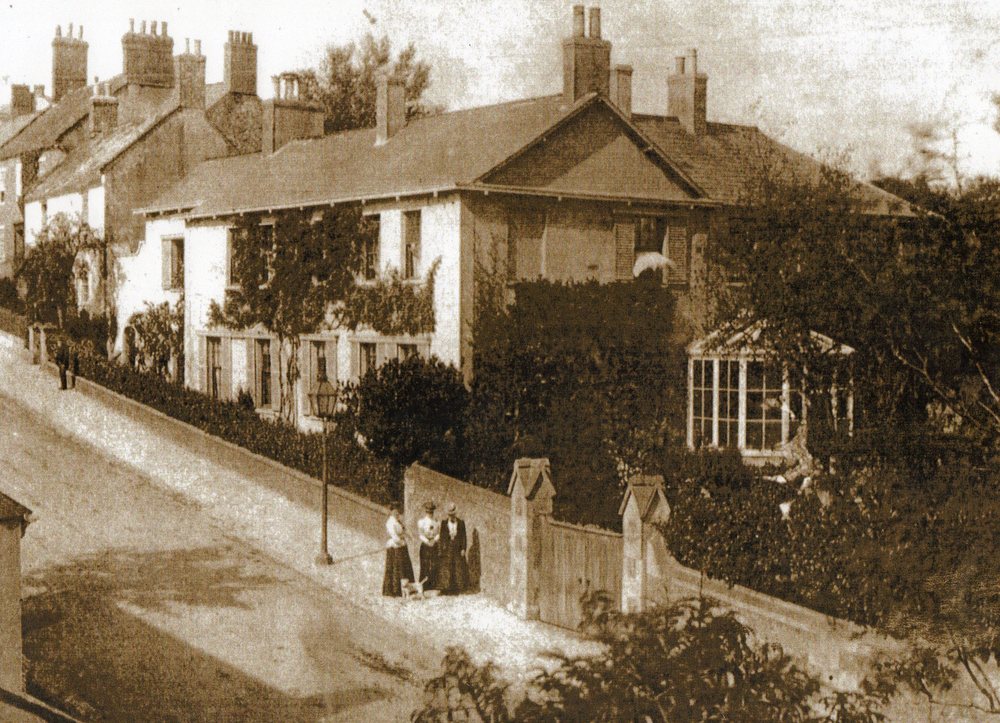 |
| Another daughter of Vernon Hugh married Alfred Haggard, brother of Rider Haggard, author of King Solomon's Mine who was a frequent visitor at 'The Court'. When he required names for two of his characters for the novel, She that he was writing in 1886, he chose Leo Vincey after Edward Vince the owner of Charmouth Stores (Nisa today) and L. Horace Holly after William Holly, the owner of Wistaria who operated the Axminster Bus from there. It was in 1873 that Alice Schalch married Alfred Haggard at Fort William in Calcutta, India where he was a barrister with the Bengal Court of Sessions. They had five children, including Admiral Sir Vernon Harry Stuart Haggard, who became Commander-in-chief of the America and West Indies station, as well as diplomat Sir Godfrey Digby Napier Haggard. In 1880 Alfred and his family arrived back from India and he took on the job of Secretary to a London Hospital. By 1888 he was renting the Limes (now Charmouth Lodge) on the Street. After he died in 1916 his wife, Alice lived at the Court for a while then moved to nearby Beech House where she died aged 74 in 1925 |
 |
The Court as shown on the 1926 Ordnance Survey Map |
The Court after Mary Elizabeth, died in 1924 was inherited by her sister, Anna Vernor (Daisy) Schalch who on her death in 1932 ended the long era of ownership by the family. The property was then sold to Mr C. White of Exeter who turned it into a large boarding house with Mrs. Buck, his daughter, as manageress. He went on to build Court Field House on the plot of ground Mrs Stuart had bought to preserve her view. It was in 1968 that Ken and Pat Stapleton bought the property and ran it for a number of years as The Court Hotel. In 1984 it became a residential home run by Jill Smith and Ross Tuck. Then in 2000 it was auctioned and purchased by former house-builder Gordon Hathway and his Norwegian wife Bodil (Bo). Part of it is now occupied by a number of small businesses whose story has been covered in depth by two earlier articles from Lesley Dunlop which can still be viewed on the Shoreline website: http://www.charmouth.org/charmouth_village/shoreline_magazine.php . As with so many buildings in Charmouth, there is a much more interesting history than first appears once you start researching into the records. So often one family occupies the house for a considerable time, as is the case with the Stuarts/Schalchs at The Court. I have used the services of the Dorset History Centre at Dorchester and the notes of Reg. Pavey in compiling this history. Neil Mattingly
|
 |
Cattle passing the Court on their way to be milked at Backlands Farm Dairy by the Old Manor House. |
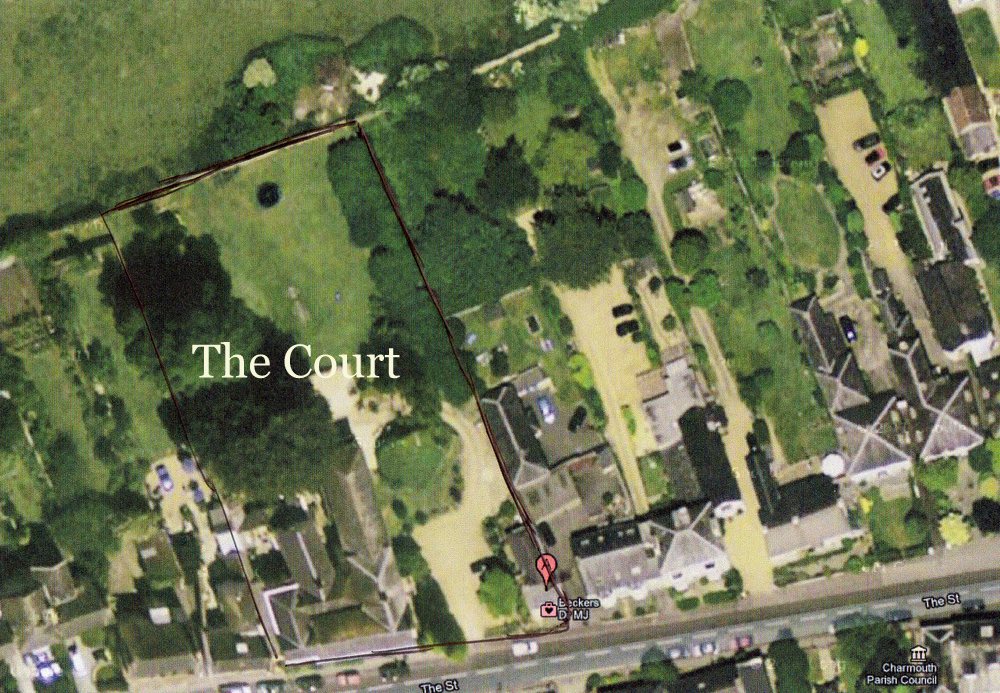 |
| |
|
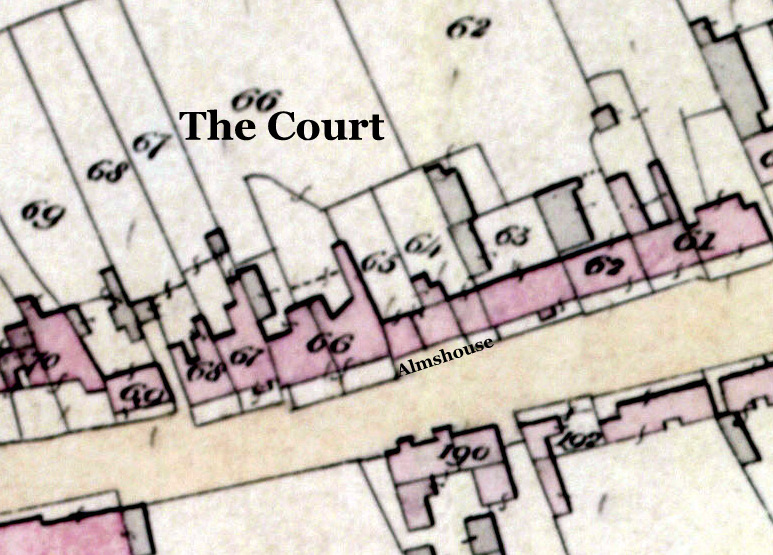





.jpg)








